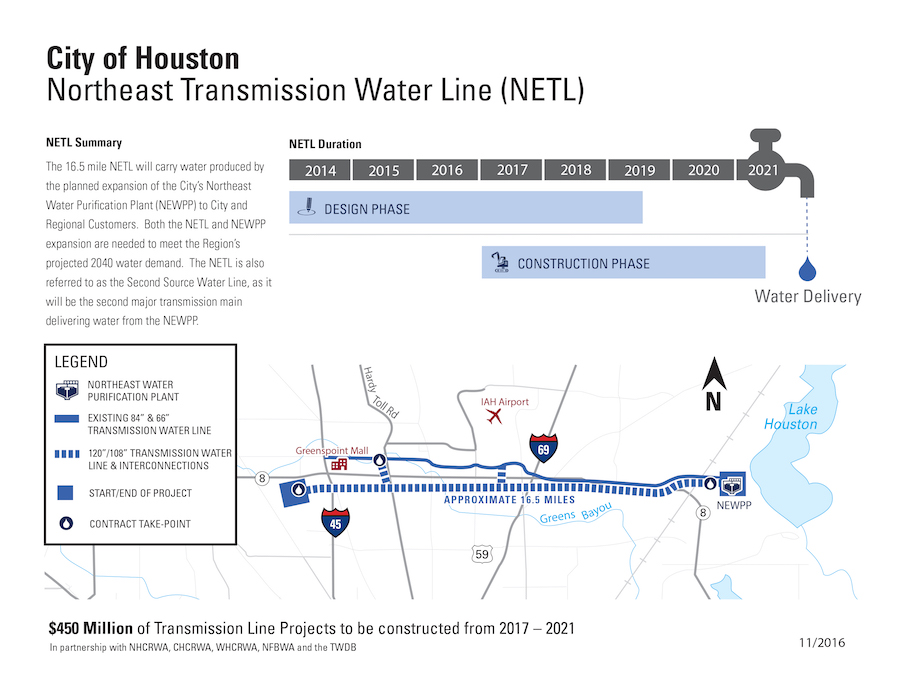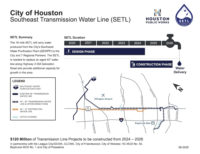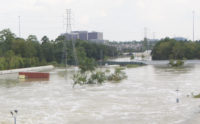Houston’s new Northeast Transmission Water Line will bring an additional 96 million gallons per day (mgd) of water to the city, plus 269 mgd to local water authorities. Construction is anticipated to start later this year, with the first in a series of segments set to be up for proposals next month. With a maximum diameter of 120 in., the line will be the largest to be built in the city, says Venus Price, supervising engineer for the Houston’s Dept. of Public Works and Engineering.
This $450-million, 16.5-mile project comprises 13 segments, 11 segments of which include large, 108-in.- to 120-in.-dia pipe. The entire project, including two interconnections, will be constructed in three phases. The line is being built as part of the city’s Surface Water Transmission Program (SWTP) to meet the region’s projected 2040 water demand.
The first phase of the project includes three segments: two 108-in. lines and a 54-in. interconnection. One of the 108-in. lines and an interconnection have already been advertised, Price says. The city is anticipating awarding by this summer all the segments under the first phase.
“The [108-in.] first project, for which we hope to get proposals on March 2, is about $28 million, and the [54-in. interconnection], for which we’ll get proposals in the middle of March, is about $12 million in construction costs,” Price says. “The award process for these projects is competitive sealed proposal, or CSP.”
Up third is a second 108-in. line, which will be about $20 million. “That’s not going to advertise until the middle of March, so we’re not expecting to get proposals for that one until April,” Price notes.
The first phase will employ both open cut and tunneling approaches, says Mackrena Ramos, senior associate and team leader for Lockwood, Andrews & Newnam Inc. (LAN), which is leading design and serving as program manager.
A feasibility study, begun in 2010, helped to determine an alignment and the pipeline diameter, Ramos explains. “There definitely were some challenges to putting a line this size in an urban environment,” she says.
Since the majority of the pipeline is in easements, the project already has required extensive planning and coordination to make sure they are all in place by the time construction starts, Ramos notes.
In the first phase, construction will begin close to the middle of the alignment, Price explains. “The reason for that is, we have a damaged portion of an existing 66-inch line that was damaged by a non-city contractor some time ago. We’re taking this opportunity to start these projects in the middle and using that interconnection, basically isolating that damaged portion of the line so that we can go in and assess and repair any damage to that line,” she says.
Phase two of the project will include three 108-in. lines and one 120-in. line, with proposals being submitted between summer 2017 and spring 2018 and awards being given between fall 2017 and spring 2018. Meanwhile, phase three will include five 108-in. lines and one 66-in. interconnection, with proposals spanning from summer 2018 to winter 2019 and awards from fall 2018 to spring 2019.
The second phase will be from the middle portion, eastward toward the Northeast Water Purification Plant, while the third phase will be from the middle portion out to I-45, Ramos says.
An ongoing Northeast Water Purification Plant expansion will provide the needed water for the Northeast Transmission Water Line, Price adds. To meet the goal of having that expansion as well as the transmission line in service by 2025, teams are starting now and working in phases, she notes.
“The 108-inch and 120-inch [pipelines] will be the biggest water lines we’ll have in the city,” Price says. “It’s a tremendous effort, and it’s going to really meet our obligations for future growth in the city, so we’re excited to get underway.”






Post a comment to this article
Report Abusive Comment